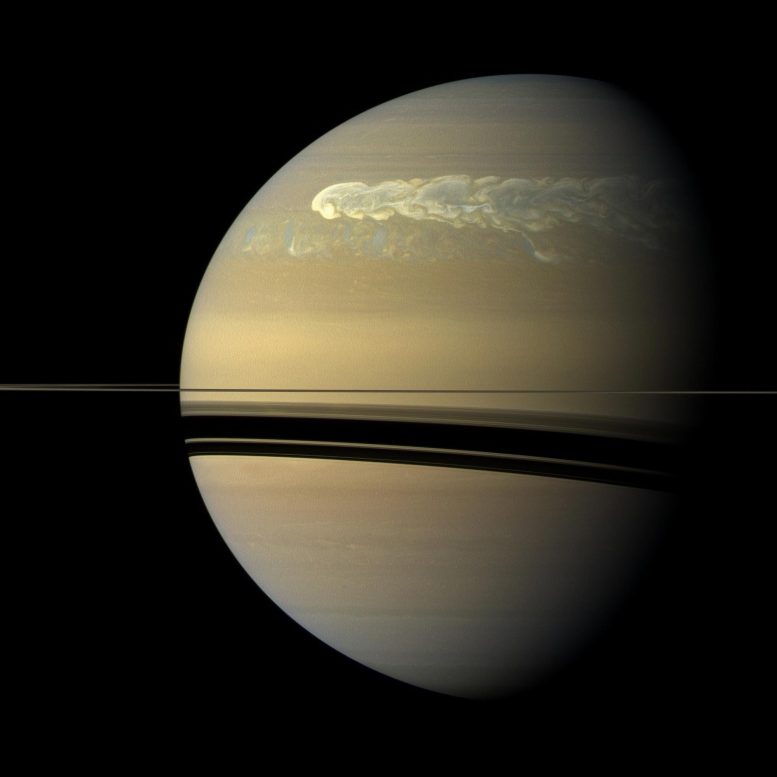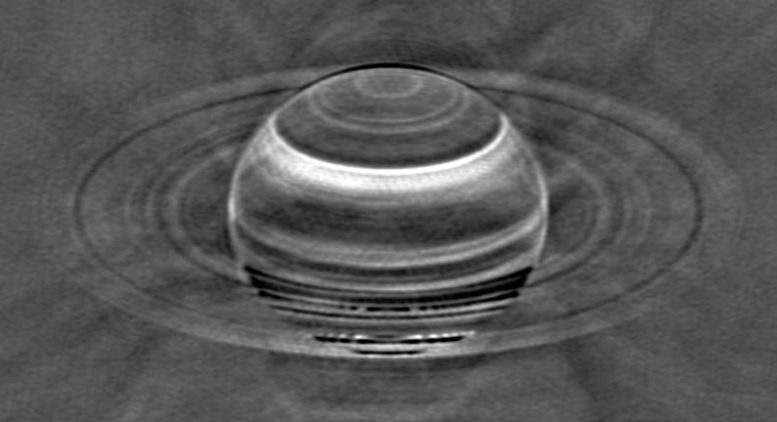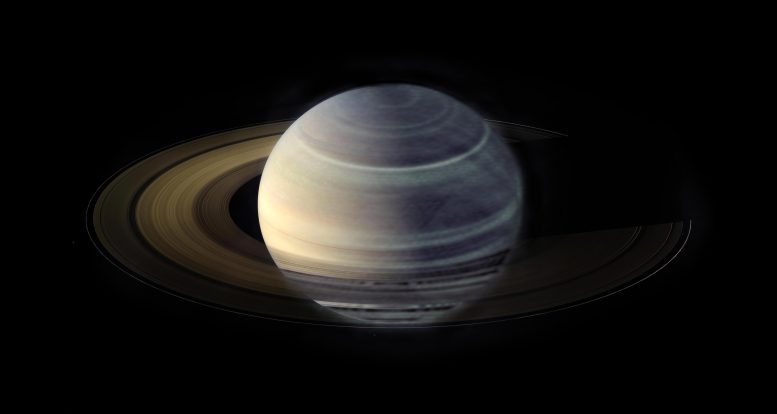
During its seven-year Solstice Mission, Cassini watched as a huge storm erupted and encircled Saturn. Scientists think storms like this are related, in part, to seasonal effects of sunlight on Saturn’s atmosphere. Credit: NASA/JPL-Caltech/Space Science Institute
Megastorms leave marks on Saturn’s atmosphere for centuries.
Researchers have discovered long-lasting megastorms on Saturn, similar to Jupiter’s Great Red Spot, through the study of radio emissions and ammonia gas disruptions. The research uncovers significant atmospheric differences between the two gas giants and challenges the current understanding of megastorms, offering new insights that may affect future studies on exoplanets.
The Great Red Spot and New Discoveries on Saturn
The largest storm in the solar system, a 10,000-mile-wide anticyclone known as the Great Red Spot, has graced Jupiter’s surface for hundreds of years.
A new study has revealed that Saturn, although more unassuming in appearance compared to Jupiter’s colorful visage, also has long-lasting megastorms. These storms have impacts deep in the atmosphere that persist for centuries.
Methodology of the Study
The research was undertaken by astronomers from the University of California, Berkeley, and the University of Michigan, Ann Arbor. They examined radio emissions from the planet, originating from beneath the surface, and discovered long-term disruptions in the distribution of ammonia gas.
The study was published on August 11 in the journal Science Advances.

Radio image of Saturn taken with the VLA in May 2015, with the brighter radio emissions from Saturn and its rings subtracted to enhance the contrast in the fainter radio emissions between the various latitudinal bands in the atmosphere. Since ammonia blocks radio waves, the bright features indicate areas where ammonia is depleted and the VLA could see deeper in the atmosphere. The broad bright band at northern latitudes is the aftermath of the 2010 storm on Saturn, which apparently depleted ammonia gas just below the ammonia-ice cloud, which is what we see with the naked eye. Credit: R. J. Sault and I. de Pater
Nature of Megastorms
Megastorms occur approximately every 20 to 30 years on Saturn and are similar to hurricanes on Earth, although significantly larger. But unlike Earth’s hurricanes, no one knows what causes megastorms in Saturn’s atmosphere, which is composed mainly of hydrogen and helium with traces of methane, water, and ammonia.
“Understanding the mechanisms of the largest storms in the solar system puts the theory of hurricanes into a broader cosmic context, challenging our current knowledge and pushing the boundaries of terrestrial meteorology,” said lead author Cheng Li, a former 51 Peg b Fellow at UC Berkeley who is now an assistant professor at the University of Michigan.
Exploration and Tools
Imke de Pater, a UC Berkeley professor emerita of astronomy and of earth and planetary sciences, has been studying gas giants for over four decades to better understand their composition and what makes them unique, employing the Karl G. Jansky Very Large Array in New Mexico to probe the radio emissions from deep inside the planet.

In the optical, Saturn’s banded atmosphere appears to smoothly shift from color to color. But seen here in radio light — VLA data overlays a Cassini image of Saturn — the distinct nature of the bands is apparent. Scientists used VLA data to better understand ammonia in the gas giant’s atmosphere and learned that megastorms transport the ammonia from the upper to the lower atmosphere. Credit: S. Dagnello (NRAO/AUI/NSF), I. de Pater et al (UC Berkeley)
“At radio wavelengths, we probe below the visible cloud layers on giant planets. Since chemical reactions and dynamics will alter the composition of a planet’s atmosphere, observations below these cloud layers are required to constrain the planet’s true atmospheric composition, a key parameter for planet formation models,” she said. “Radio observations help characterize dynamical, physical and chemical processes including heat transport, cloud formation and convection in the atmospheres of giant planets on both global and local scales.”
Surprising Findings
As reported in the new study, de Pater, Li and UC Berkeley graduate student Chris Moeckel found something surprising in the radio emissions from the planet: anomalies in the concentration of ammonia gas in the atmosphere, which they connected to the past occurrences of megastorms in the planet’s northern hemisphere.
Impact on Ammonia Concentration and Atmospheric Differences
According to the team, the concentration of ammonia is lower at midaltitudes, just below the uppermost ammonia-ice cloud layer, but has become enriched at lower altitudes, 100 to 200 kilometers deeper in the atmosphere. They believe that the ammonia is being transported from the upper to the lower atmosphere via the processes of precipitation and reevaporation. What’s more, that effect can last for hundreds of years.
Comparing Saturn and Jupiter
The study further revealed that although both Saturn and Jupiter are made of hydrogen gas, the two gas giants are remarkably different. While Jupiter does have tropospheric anomalies, they have been tied to its zones (whitish bands) and belts (darkish bands) and are not caused by storms like they are on Saturn. The considerable difference between these neighboring gas giants challenges current understanding about the formation of megastorms on gas giants and other planets. It may also influence how these storms are found and examined on exoplanets in the future.
Reference: “Long-lasting, deep effect of Saturn’s giant storms” by Cheng Li, Imke de Pater, Chris Moeckel, R. J. Sault, Bryan Butler, David deBoer and Zhimeng Zhang, 11 August 2023, Science Advances.
DOI: 10.1126/sciadv.adg9419
The National Radio Astronomy Observatory (NRAO) is a facility of the National Science Foundation, operated under cooperative agreement by Associated Universities Inc.
Article From & Read More ( Megastorms on Saturn: 100-Year-Long Storms Challenge Our Understanding of Gas Giants - SciTechDaily )https://ift.tt/0XtPzAx
Science
No comments:
Post a Comment